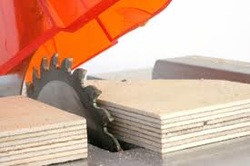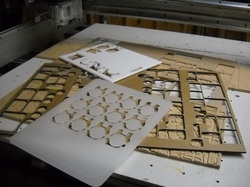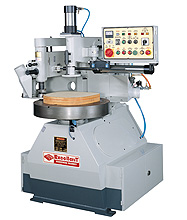"Where Quality And Quantity Comes Together!"
501-844-4210
501-844-4210
Wood Industry Resource and Education Page
Medium-Density Fibreboard (MDF)
Medium-density fibreboard (MDF) is an engineered wood product formed by breaking down hardwood or softwood residuals into wood fibers, often in a defibrator, combining it with wax and a resin binder, and forming panels by applying high temperature and pressure.[1] MDF is denser than plywood.
It is made up of separated fibers, (not wood veneers) but can be used as a building material similar in application to plywood. It is stronger and much more dense than normal particle board.
The name derives from the distinction in densities of fiberboard. Large-scale production of MDF began in the 1980s [1].[citation needed]
Contents [hide]
[edit] Comparison to natural woods MDF does not contain knots or rings, making it more uniform than natural woods during cutting and in service.[2] However, MDF is not entirely isotropic, since the fibers are pressed together primarily through the sheet. Like natural wood, MDF may split when woodscrews are installed without pilot holes, and MDF may be glued, doweled or laminated, but smooth-shank nails do not hold well. Typical fasteners are T-nuts and pan-head machine screws.[3] The mass density of MDF is between 600 kg/m3 and 1200 kg/m3.
[edit] Safety aspects of MDF When MDF is cut a large quantity of dust particles are released into the air. It is important that a respirator be worn and the material be cut in a controlled and ventilated environment. It is a good practice to seal the exposed edges to limit the emissions from the binders contained in this material.
Formaldehyde resins are commonly used to bind MDF together, and testing has consistently revealed that MDF products emit urea-formaldehyde and other volatile organic compounds that pose health risks at sufficient concentrations, for at least several months after manufacture.[4][5][6] Urea-formaldehyde is always being slowly released from the surface of MDF. When painting it is good idea to coat the whole of the product in order to seal in the urea-formaldehyde. Wax and oil finishes may be used as finishes but they are less effective at sealing in the urea-formaldehyde.[2]
Whether these chronic emissions of formaldehyde reach harmful levels in real-world environments is not yet fully determined. The primary concern is for the industries using formaldehyde. As far back as 1987 the U.S. EPA classified it as a "probable human carcinogen" and after more studies the WHO International Agency for Research on Cancer (IARC), in 1995, also classified it as a "probable human carcinogen". Further information and evaluation of all known data led the IARC to reclassify formaldehyde as a "known human carcinogen"[7] associated with nasal sinus cancer and nasopharyngeal cancer, and possibly with leukemia in June 2004.[8]
[edit] References
It is made up of separated fibers, (not wood veneers) but can be used as a building material similar in application to plywood. It is stronger and much more dense than normal particle board.
The name derives from the distinction in densities of fiberboard. Large-scale production of MDF began in the 1980s [1].[citation needed]
Contents [hide]
- 1 Physical Properties
- 2 Comparison to natural woods
- 3 Safety aspects of MDF
- 4 References
- 5 External links
[edit] Comparison to natural woods MDF does not contain knots or rings, making it more uniform than natural woods during cutting and in service.[2] However, MDF is not entirely isotropic, since the fibers are pressed together primarily through the sheet. Like natural wood, MDF may split when woodscrews are installed without pilot holes, and MDF may be glued, doweled or laminated, but smooth-shank nails do not hold well. Typical fasteners are T-nuts and pan-head machine screws.[3] The mass density of MDF is between 600 kg/m3 and 1200 kg/m3.
[edit] Safety aspects of MDF When MDF is cut a large quantity of dust particles are released into the air. It is important that a respirator be worn and the material be cut in a controlled and ventilated environment. It is a good practice to seal the exposed edges to limit the emissions from the binders contained in this material.
Formaldehyde resins are commonly used to bind MDF together, and testing has consistently revealed that MDF products emit urea-formaldehyde and other volatile organic compounds that pose health risks at sufficient concentrations, for at least several months after manufacture.[4][5][6] Urea-formaldehyde is always being slowly released from the surface of MDF. When painting it is good idea to coat the whole of the product in order to seal in the urea-formaldehyde. Wax and oil finishes may be used as finishes but they are less effective at sealing in the urea-formaldehyde.[2]
Whether these chronic emissions of formaldehyde reach harmful levels in real-world environments is not yet fully determined. The primary concern is for the industries using formaldehyde. As far back as 1987 the U.S. EPA classified it as a "probable human carcinogen" and after more studies the WHO International Agency for Research on Cancer (IARC), in 1995, also classified it as a "probable human carcinogen". Further information and evaluation of all known data led the IARC to reclassify formaldehyde as a "known human carcinogen"[7] associated with nasal sinus cancer and nasopharyngeal cancer, and possibly with leukemia in June 2004.[8]
[edit] References
- ^ Spence, 2005, p. 114
- ^ a b Medium Density Fibreboard
- ^ MDF Board FAQ - Tutorial
- ^ http://www.fpl.fs.fed.us/documnts/pdf1986/myers86a.pdf
- ^ Sources of formaldehyde, other aldehydes and terpenes in a new manufactured house - Hodgson - 2002 - Indoor Air - Wiley Online Library
- ^ http://www.fpl.fs.fed.us/documnts/pdf2000/bauma00a.pdf
- ^ "IARC Monographs on the Evaluation of Carcinogenic Risks to Humans Volume 88 (2006) Formaldehyde, 2-Butoxyethanol and 1-tert-Butoxypropan-2-ol". WHO Press. 2006. http://monographs.iarc.fr/ENG/Monographs/vol88/.
- ^ "Formaldehyde and Cancer Risk". http://www.cancer.gov/cancertopics/factsheet/Risk/formaldehyde.
- Jesberger, Lee FX-Platform
- HCHO_Certificate Norboard
- Lignocellulosic Composites
- Design-Technology.Org
- Spence, William P. (2005). The Home Carpenters & Woodworker's Repair Manual. New York: Sterling. ISBN 1-4027-1055-0
- Pro Woodworking Tips.com
- A video podcast from podcastschool.net
- Wood Dust - dangers of exposure to wood dust, including MDF dust (from the Worker's Health Centre)
- Formaldehyde An Introduction to Indoor Air Quality: Formaldehyde
- Medium Density Fiberboard - from Investment New Zealand, a division of New Zealand's economic development agency.
- The Medium Density Fiberboard Home Page (although not updated or maintained, still a valuable reference)
- http://www.medite-europe.com
Parts Cut-To-Size utilizing our state of the art CNC Horizontal Panel Saws.

CUT-TO-SIZE PANEL PARTS:
Jay Bird Manufacturing CO., Inc. has two High Tech CNC panel saws with a sheet capacity of 61" x 145" and a part tolerance of +/- 0.008". Panel Products include OSB, Particle Board, MDF, Hardwood Plywoods, BeadBoard and other wood sheet components.
Jay Bird Manufacturing CO., Inc. has two High Tech CNC panel saws with a sheet capacity of 61" x 145" and a part tolerance of +/- 0.008". Panel Products include OSB, Particle Board, MDF, Hardwood Plywoods, BeadBoard and other wood sheet components.
Parts Cut-To-Size utilizing our state of the art NC Cross Cut Saws

CUT-TO-SIZE LUMBER PARTS:
Jay Bird Manufacturing Co., Inc. has two Numerical Controlled Cut Off saws capable of cutting bunks of lumber and panels up to 8" x 11", 6" x 14", 4 x 16" or 2" x 17", utilizing the best yields and performance available in the market today. These high speed, highly accurate saws cross cut your material with a precision and squareness of cut, ensuring products meet your standards exacting standards.
Jay Bird Manufacturing Co., Inc. has two Numerical Controlled Cut Off saws capable of cutting bunks of lumber and panels up to 8" x 11", 6" x 14", 4 x 16" or 2" x 17", utilizing the best yields and performance available in the market today. These high speed, highly accurate saws cross cut your material with a precision and squareness of cut, ensuring products meet your standards exacting standards.
Parts Machined, Shaped utilizing our state of the art CNC Routers & Machining Centers

Shaped to Size Panel Parts:
Jay Bird Manufacturing CO., Inc. has several High Tech CNC Routers and Machining Centers with a maximum sheet capacity of 61" x 145" and a part tolerances of +/- 0.004". Both Nested, and individual component part processing available. We can assist you with custom engineering and we have an investment in the latest CNC equipment to assist you in providing Scalability of Resources. Wood, Plastics, and Non-Ferrous metals machined. Machining operations include surface boring, edge boring and routing. We cut components to size utilizing our CNC's and can shape complex geometric shapes to order.
Jay Bird Manufacturing CO., Inc. has several High Tech CNC Routers and Machining Centers with a maximum sheet capacity of 61" x 145" and a part tolerances of +/- 0.004". Both Nested, and individual component part processing available. We can assist you with custom engineering and we have an investment in the latest CNC equipment to assist you in providing Scalability of Resources. Wood, Plastics, and Non-Ferrous metals machined. Machining operations include surface boring, edge boring and routing. We cut components to size utilizing our CNC's and can shape complex geometric shapes to order.
Parts Machined, Dimensioned, Profiled utilizing our state of the art Moulders

With our moulders we are capable of manufacturing longitudinal products made of
solid wood, boards such as MDF, plastic or similar materials. In one run your products can be planed, profiled or rip sawed. The transport
through the machine is carried out by numerous feed rollers and the machine is capable of running up to 100ft per minute depending on the application. In addition, we have the capability of running material up to 12" wide x 6" thick.
Round, Rectangular, Radius Cornered Parts with or without Edge Shaping

Several in house copy shapers are available to profile complex parts requiring edge profiling and shaping. These edges can include waterfall, bullnose, chamfered and custom profiled. Part sizes can range from 3 ~28". These machines are designed for medium & small work pieces shaping
& profiling. They are high production machines and afford the best

